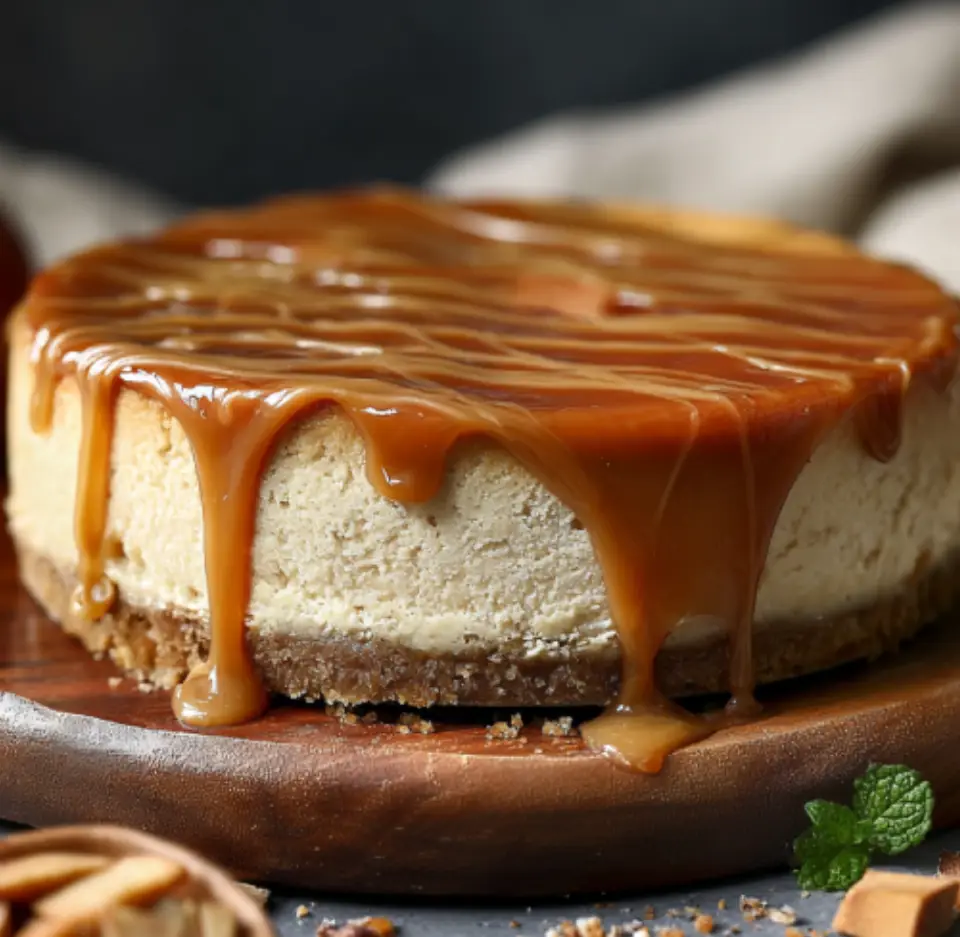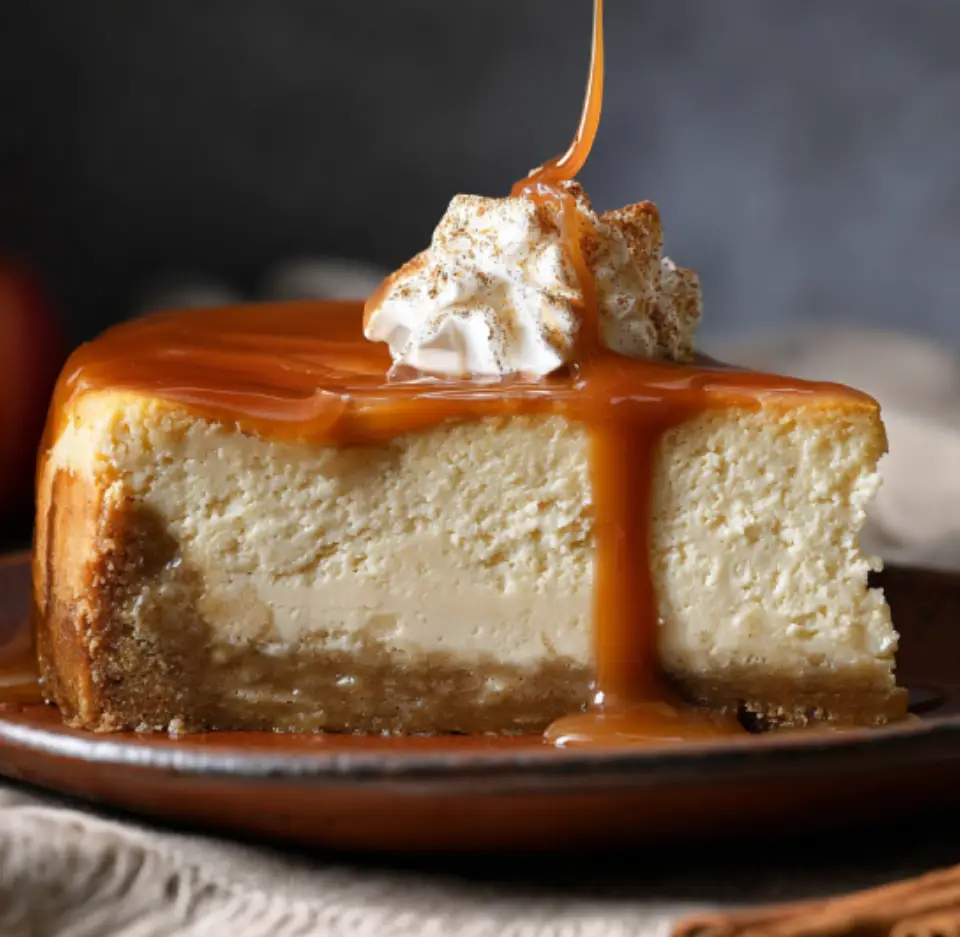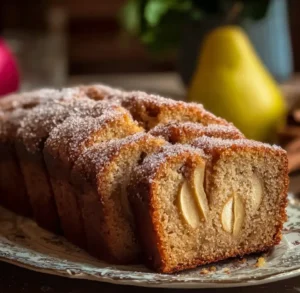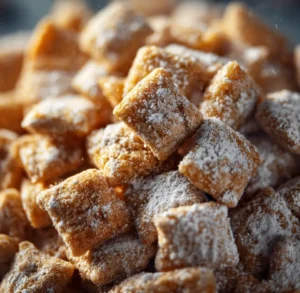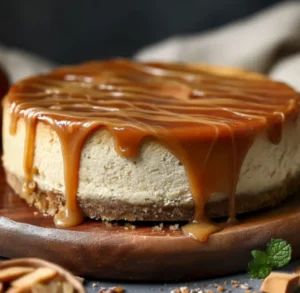Discover the extraordinary magic of this sublime apple cider cheesecake that celebrates autumn’s finest flavors because it transforms fresh apple cider into a lusciously creamy dessert that captures the essence of fall in every velvety bite. This spectacular apple cider cheesecake delivers the perfect balance of tangy cream cheese and sweet-tart apple cider because the reduction process concentrates the cider’s natural sugars and acids, creating intense flavor that permeates the entire cheesecake from the buttery graham cracker crust to the smooth, silky filling.
Why Apple Cider Cheesecake Reigns Supreme
This magnificent apple cider cheesecake succeeds brilliantly because it offers a sophisticated alternative to pumpkin desserts while celebrating autumn with equal enthusiasm and superior complexity. The reduced apple cider provides concentrated flavor because simmering evaporates water content, leaving behind intensified apple essence, natural sugars, and tangy acidity that creates dimensional taste impossible to achieve with apple juice or extracts.
The genius of this apple cider cheesecake lies in its textural perfection because the slow-baking method with steam creates uniformly creamy texture throughout, while the gradual cooling process prevents cracking and maintains the pristine surface. The combination of cream cheese tanginess and apple cider sweetness creates harmonious balance because neither element overwhelms, instead working together to produce a dessert that tastes both familiar and excitingly different.
This exceptional apple cider cheesecake appeals to discerning palates because the subtle cinnamon enhancement complements rather than dominates the apple flavor, allowing the star ingredient to shine while adding warmth that makes the dessert feel cozy and seasonally appropriate. The recipe demonstrates how patience and proper technique transform simple ingredients into extraordinary results because great cheesecake cannot be rushed or compromised.
Essential Ingredients for Perfect Apple Cider Cheesecake
For the Graham Cracker Crust:
- 2 cups graham cracker crumbs, finely crushed
- 1/4 cup granulated sugar
- 1/2 teaspoon ground cinnamon
- 6 tablespoons unsalted butter, melted
- Pinch of salt
For the Apple Cider Reduction:
- 3 cups fresh apple cider, preferably Honeycrisp or tart variety
For the Cheesecake Filling:
- 32 ounces cream cheese, softened to room temperature
- 1 cup granulated sugar
- 3 tablespoons all-purpose flour, optional for extra stability
- 1 teaspoon ground cinnamon
- 1/4 teaspoon salt
- 1 cup sour cream, room temperature
- 1 tablespoon pure vanilla extract
- 4 large eggs, room temperature
- 1/2 cup reduced apple cider, cooled
For Optional Topping:
- Apple cider caramel sauce
- Cinnamon whipped cream
- Fresh apple slices, macerated in lemon juice
The Art of Creating Apple Cider Cheesecake
Mastering this divine apple cider cheesecake requires understanding the relationship between temperature, texture, and timing because successful cheesecake baking depends on gentle heat, proper ingredient preparation, and patience during the cooling process. The apple cider reduction represents the crucial first step because this concentrated flavor base determines the final taste intensity, with longer reduction creating stronger apple presence.
The cream cheese preparation proves essential because properly softened cheese blends smoothly without lumps, creating the silky texture that distinguishes superior cheesecake from grainy disappointments. The gradual addition of eggs prevents over-incorporation of air because excessive aeration creates bubbles that mar the surface and compromise the dense, creamy texture.
Temperature control throughout baking becomes critical because this apple cider cheesecake bakes at moderate heat in a steam-enhanced environment that prevents cracking while ensuring even cooking from edge to center. The extended cooling period allows proteins to set gradually because rapid temperature changes cause structural stress that results in sunken centers and surface cracks.
Step-by-Step Instructions for Apple Cider Cheesecake
Step 1: Reduce the Apple Cider
Pour fresh apple cider into a medium saucepan and bring to a gentle boil over medium-high heat because rapid boiling initiates the evaporation process necessary for concentration. Reduce heat to maintain steady simmer and cook for 45-60 minutes until reduced to 1/2 cup because this concentration intensifies flavor dramatically.
Professional Tip: Use a clear glass measuring cup to check volume periodically because visual monitoring ensures precise reduction without over-concentrating, which can create bitter flavors.
Key Points: Cool the reduced cider completely to room temperature before incorporating into the filling because hot liquid can scramble eggs and affect the cream cheese texture adversely.
Step 2: Prepare the Crust
Preheat oven to 325°F and wrap the outside of a 9-inch springform pan with two layers of heavy-duty aluminum foil because this waterproofing protects against water bath leakage. Combine graham cracker crumbs, sugar, cinnamon, melted butter, and salt because these ingredients create the foundation for flavor and structure.
Professional Tip: Press the mixture firmly into the bottom and slightly up the sides using a flat-bottomed measuring cup because even compression creates uniform texture and prevents crumbling.
Key Points: Bake the crust for 10 minutes until fragrant and lightly golden because pre-baking creates a moisture barrier that prevents soggy bottom while developing deeper flavor.
Step 3: Beat the Cream Cheese
Process softened cream cheese in a food processor or beat with a mixer on medium speed for 2-3 minutes until completely smooth because this initial beating eliminates lumps that cannot be removed later. Scrape down the bowl sides frequently because thorough mixing ensures uniform texture throughout.
Professional Tip: Check cream cheese temperature with your finger because it should feel cool but pliable, not cold and firm or warm and soft.
Key Points: Avoid high-speed beating because excessive air incorporation creates bubbles that rise during baking and mar the surface with small craters.
Step 4: Add Sugar and Dry Ingredients
Combine granulated sugar, flour, cinnamon, and salt with the cream cheese, mixing on medium-low speed until smooth because gradual incorporation prevents overwhelming the processor or creating clouds of flour. Mix only until ingredients disappear because over-mixing at this stage develops unwanted air pockets.
Professional Tip: Sift the flour before adding because this ensures even distribution and prevents flour clumps from forming in the batter.
Key Points: The mixture should appear thick, smooth, and glossy because proper consistency at this stage guarantees excellent final texture.
Step 5: Incorporate Wet Ingredients
Add the cooled reduced apple cider, sour cream, and vanilla extract to the cream cheese mixture, blending on low speed until just combined because these ingredients thin the batter while adding moisture and flavor. Mix only until incorporated because over-mixing develops air bubbles.
Professional Tip: Use sour cream at room temperature because cold dairy can cause the cream cheese to seize up and create lumpy texture.
Key Points: The batter should flow smoothly but retain body because proper consistency ensures the filling sets correctly during baking.
Step 6: Add Eggs Carefully
Add eggs one at a time, mixing on the lowest speed until just incorporated after each addition because gentle handling prevents over-aeration. Stop mixing as soon as the egg disappears because over-beating creates foam that affects texture negatively.
Professional Tip: Crack eggs into a separate bowl first because this allows you to remove any shell fragments and check for freshness before adding to the batter.
Key Points: The final batter should appear thick, creamy, and smooth without visible streaks or bubbles because proper mixing technique creates the ideal consistency for baking.
Step 7: Pour and Prepare for Baking
Pour the filling over the cooled crust, tapping the pan gently on the counter to release air bubbles because trapped air creates holes in the finished cheesecake. Smooth the top with an offset spatula because even surfaces bake more uniformly.
Professional Tip: Place a large roasting pan on the oven rack and position the wrapped springform pan inside before filling the roasting pan with hot water because this setup is easier than carrying a water-filled pan.
Key Points: The water should reach halfway up the springform pan sides because adequate steam creates the moist environment necessary for crack-free baking.
Step 8: Bake with Patience
Bake at 325°F for 70-80 minutes until the edges are set but the center still jiggles slightly because residual heat continues cooking during cooling. Turn off the oven, crack the door, and let the cheesecake cool inside for one hour because gradual temperature reduction prevents thermal shock.
Professional Tip: Check doneness by gently shaking the pan because the center should wiggle like gelatin while the edges remain firm.
Key Points: Remove from the oven when the internal temperature reaches 150°F because carryover cooking brings it to the perfect 155°F final temperature.
Step 9: Cool and Chill
Remove the cheesecake from the water bath and cool on a wire rack to room temperature for 2-3 hours because slow cooling prevents surface cracking. Cover loosely with plastic wrap and refrigerate for at least 8 hours or overnight because extended chilling allows flavors to develop and texture to set completely.
Professional Tip: Run a thin knife around the pan edge before chilling because this prevents the cheesecake from sticking and cracking as it contracts during cooling.
Key Points: Patience during this stage proves essential because properly chilled apple cider cheesecake slices cleanly and tastes significantly better than under-chilled versions.
Professional Tips for Perfect Apple Cider Cheesecake
Quality apple cider makes a dramatic difference because fresh, unfiltered cider from local orchards contains more complex flavors than mass-produced varieties, resulting in superior taste that justifies the extra effort to source excellent cider. Choose tart apple varieties like Honeycrisp because their higher acid content creates better flavor balance when reduced.
Room temperature ingredients prove crucial because cold cream cheese, eggs, and sour cream resist blending smoothly, creating lumpy texture that persists in the finished apple cider cheesecake. Plan ahead and remove dairy from refrigeration 2-3 hours before beginning because proper temperature ensures silky results.
Invest in an instant-read thermometer because accurate temperature monitoring eliminates guesswork and ensures perfect doneness every time, preventing both underbaked centers and overbaked edges. Clean your knife between slices because wiping after each cut creates professional-looking portions with clean edges.
Creative Variations for Apple Cider Cheesecake
Transform this classic apple cider cheesecake into exciting alternatives because customization allows exploration of complementary flavors and textures. Try adding chopped dried apples to the crust because these provide textural interest and concentrated apple flavor that enhances the overall experience.
Incorporate other warming spices such as nutmeg, allspice, or cardamom because these aromatics create more complex flavor profiles reminiscent of mulled cider. Swirl apple butter or apple pie filling through the batter before baking because these additions create visual interest and pockets of concentrated fruit flavor.
Create mini versions in muffin tins because individual servings provide portion control and elegant presentation for parties and gatherings. Top with caramelized apple slices because the combination of creamy cheesecake and tender, sweet apples creates textural contrast that elevates the dessert.
Perfect Pairing Ideas for Apple Cider Cheesecake
This elegant apple cider cheesecake pairs beautifully with complementary flavors and beverages because thoughtful accompaniments enhance the dining experience. Serve alongside other delightful dessert recipes because variety creates more interesting dessert spreads for special occasions.
Consider offering light snacks and appetizers before dessert because small savory bites prepare palates for sweet endings. Balance the richness with fresh salad options during the main course because the complete meal should flow harmoniously.
Hot apple cider or spiced tea complements perfectly because these beverages echo the dessert’s flavor profile while providing warmth. Serve with vanilla ice cream or cinnamon whipped cream because these additions enhance rather than compete with the apple cider flavor.
Discover More Autumn-Inspired Recipes
Expand your seasonal baking repertoire with complementary recipes that celebrate fall flavors because building a collection of autumn desserts provides options for various occasions. Explore creative savory side dish preparations because balancing sweet and savory dishes creates complete menus.
Enhance your entertaining with flavorful dips and marinades because versatile preparations accommodate different gathering styles. Include refreshing beverage ideas because well-planned drinks complement desserts perfectly.
Consider breakfast favorite applications because apple cider cheesecake filling can inspire morning pastries and sweet breads that extend seasonal flavors throughout the day.
Storage Guidelines for Apple Cider Cheesecake
Proper storage techniques preserve both flavor and texture because this apple cider cheesecake remains delicious for nearly a week when handled correctly. Cover tightly with plastic wrap or store in an airtight container because exposure to air causes surface drying and flavor absorption from other refrigerator contents.
Refrigerate for up to 5-6 days because the high dairy content remains stable during this period, though optimal texture and flavor occur within the first three days. Freeze individual slices wrapped in plastic wrap and aluminum foil for up to two months because proper wrapping prevents freezer burn.
Thaw frozen slices in the refrigerator overnight because gradual temperature change preserves texture better than room temperature thawing. Bring to cool room temperature 30 minutes before serving because slightly warmed cheesecake offers superior flavor and creamier texture.
The Science Behind Perfect Apple Cider Cheesecake
Understanding dairy protein behavior improves results because casein proteins in cream cheese coagulate during baking, creating the firm yet creamy structure characteristic of excellent cheesecake. The eggs provide additional protein that reinforces structure while contributing richness and binding properties.
The water bath creates humid environment because steam prevents surface moisture loss that causes cracking and drying. The gradual cooling process allows protein networks to relax slowly because rapid temperature drops create stress that manifests as cracks and sunken centers.
Acid from both cream cheese and reduced apple cider affects protein structure because it partially denatures proteins, contributing to the tender texture that makes this apple cider cheesecake melt-in-your-mouth delicious rather than rubbery.
Troubleshooting Common Apple Cider Cheesecake Issues
Cracks form when temperature changes too rapidly because thermal stress exceeds the protein structure’s ability to contract smoothly. Use a water bath, cool gradually, and avoid over-baking because these precautions prevent the conditions that cause cracking.
Grainy texture results from over-mixing or under-softened cream cheese because both conditions prevent smooth emulsion formation. Ensure proper ingredient temperature and mix gently because these practices create silky consistency.
Sunken center occurs from over-baking or cooling too quickly because these conditions cause excessive protein coagulation followed by dramatic collapse. Monitor temperature carefully and cool gradually because proper technique maintains level surface.
Additional Fall Dessert Inspirations
Continue seasonal baking exploration with related perfect side dish options because complete meal planning considers all courses. Apple-based desserts pair naturally with autumn menus because their flavors complement traditional fall ingredients.
Build confidence with similar custard-based desserts because mastering cheesecake technique opens doors to pies, tarts, and other elegant preparations. Remember that baking success improves with repetition because each attempt refines your understanding and develops instinct.
Conclusion
This magnificent apple cider cheesecake represents the pinnacle of autumn desserts because it transforms seasonal cider into an elegant, sophisticated treat that celebrates fall’s finest flavors without relying on predictable pumpkin. The combination of concentrated apple cider, tangy cream cheese, and warming spices creates unforgettable taste experiences because each element contributes unique characteristics that harmonize beautifully.
Whether preparing for Thanksgiving celebrations, holiday gatherings, or simply indulging in seasonal baking, this apple cider cheesecake guarantees impressive results because the technique, though time-intensive, proves remarkably forgiving and produces consistently stunning outcomes. The recipe’s adaptability allows for creative exploration because variations and topping options accommodate personal preferences while maintaining the essential apple character that makes this cheesecake truly special and absolutely unforgettable.

